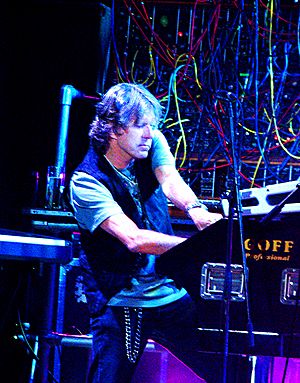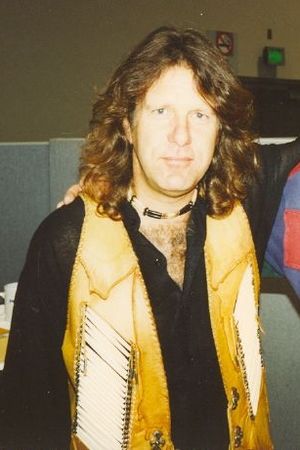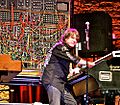Keith Emerson facts for kids
Quick facts for kids
Keith Emerson
|
|
|---|---|

Emerson performing in Saint Petersburg, Russia, September 2008
|
|
| Born |
Keith Noel Emerson
2 November 1944 Todmorden, West Riding of Yorkshire, England
|
| Died | 11 March 2016 (aged 71) Santa Monica, California, U.S.
|
| Resting place | Lancing, West Sussex, UK |
| Occupation | Musician, songwriter, composer, arranger, producer |
| Years active | 1964–2016 |
| Children | 2 |
| Musical career | |
| Genres | |
| Instruments | Keyboards, synthesizer, piano |
Keith Noel Emerson (2 November 1944 – 11 March 2016) was an English musician and composer.
He was widely regarded as one of the top keyboard players of the progressive rock era. AllMusic describes Emerson as "perhaps the greatest, most technically accomplished keyboardist in rock history".
Contents
Early life
Emerson was born on 2 November 1944 in Todmorden, West Riding of Yorkshire. The family had been evacuated from southern England during World War II, after which they returned south and settled in Goring-by-Sea, West Sussex. Emerson attended West Tarring School in Tarring. His mother Dorothy was not musical, but his father Noel was an amateur pianist and taught Emerson basic piano. When Emerson was eight, his parents arranged formal tuition, learning to play and read music with "local little old ladies" until he was around thirteen, with whom he studied to ABRSM Grade 7. Emerson's teacher put him in competitions at the Worthing Music Festival and suggested he finish studying music in London, but Emerson had little interest in classical music at the time and chose jazz piano. His studies in Western classical music largely inspired his own style in his professional career which often incorporated jazz and rock elements.
Although Emerson did not own a record player, he enjoyed listening to music on the radio, particularly Floyd Cramer's 1961 slip note-style "On the Rebound" and the work of Dudley Moore. He used jazz sheet music from Dave Brubeck and George Shearing and learned about jazz piano from books and Andre Previn's version of My Fair Lady. He also listened to boogie-woogie, and to country-style pianists including Joe "Mr Piano" Henderson, Russ Conway and Winifred Atwell. Emerson later described himself: "I was a very serious child. I used to walk around with Beethoven sonatas under my arm. However, I was very good at avoiding being beaten up by the bullies. That was because I could also play Jerry Lee Lewis and Little Richard songs. So, they thought I was kind of cool and left me alone."
Emerson became interested in the Hammond organ after hearing jazz organist Jack McDuff perform "Rock Candy", and the Hammond became his instrument of choice in the late 1960s. Emerson acquired his first Hammond organ, an L-100 model, at the age of 15 or 16, on hire purchase and a loan from his father. He had saved money to buy a Bird electric organ with built-in speakers on each side, but then spotted a Hammond in the shop and thought it was a better purchase. Emerson's initial plan was for a non-musical career while playing the piano on the side. Upon leaving school he worked at Lloyds Bank Registrars where he played the piano in the bar at lunch times and local pubs at nights. He was ultimately fired from the bank.
Career
Emerson played keyboards in a number of bands before finding his first commercial success with the Nice in the late 1960s. He became internationally famous for his work with the Nice, which included writing rock arrangements of classical music. After leaving the Nice in 1970, he was a founding member of Emerson, Lake & Palmer (ELP), one of the early progressive rock supergroups.
Emerson, Lake & Palmer were commercially successful through much of the 1970s, becoming one of the best-known progressive rock groups of the era. Emerson wrote and arranged much of ELP's music on albums such as Tarkus (1971) and Brain Salad Surgery (1973), combining his own original compositions with classical or traditional pieces adapted into a rock format.
Following ELP's break-up at the end of the 1970s, Emerson pursued a solo career, composed several film soundtracks, and formed the bands Emerson, Lake & Powell and 3 to carry on in the style of ELP. In the early 1990s, Emerson rejoined ELP, which reunited for two more albums and several tours before breaking up again in the late 1990s. Emerson also reunited the Nice in 2002 for a tour.
During the 2000s, Emerson resumed his solo career, including touring with his own Keith Emerson Band and collaborating with several orchestras. He reunited with ELP bandmate Greg Lake in 2010 for a duo tour, finishing in a one-off ELP reunion show in London to celebrate the band's 40th anniversary. Emerson's last album, The Three Fates Project, was released in 2012.
Death
Emerson reportedly suffered from depression, and in his later years developed nerve damage that hampered his playing, making him anxious about upcoming performances. He took his own life on 11 March 2016 at his home in Santa Monica, California.
Personal life
Around Christmas 1969, Emerson married his Danish girlfriend Elinor Lund. They had two sons, Aaron and Damon, before they divorced in 1994. Emerson then had a long-term relationship with Mari Kawaguchi.
In April 1975, Emerson's Sussex house burned down and he relocated to London.
Emerson enjoyed flying as a hobby, and he obtained his pilot's licence in 1972.
Playing style
Emerson sometimes reached into the interior of his piano and hit, plucked, or strummed the strings with his hand. He said that as a keyboard player, he hated the idea of being "static" and that to avoid it, he "wanted to get inside the piano, brush the strings, stick Ping-Pong balls inside". "Take a Pebble" included Emerson strumming the strings of his piano, a technique pioneered by avant-garde composer Henry Cowell, referred to as string piano. In the Nice's 1968 live performance of "Hang on to a Dream" on the German television program Beat-Club (later released on DVD in 1997), Emerson can be seen and heard reaching inside his grand piano at one point and plucking its strings.
In addition to such experimentation, Emerson also incorporated unique musical stylization into his work. Emerson is recognized for having integrated different sounds into his writing, utilizing methods of both horizontal and vertical contrast. Horizontal contrast is the use of distinct styles in a piece of music, combined by alternating between two different segments (in Emerson's case, most frequently alternating classical and non-classical); this technique can be seen in numerous works, such as "Rondo", "Tantalising Maggie", "The Thoughts of Emerlist Davjack" and others. Vertical contrast is the combination of multiple styles simultaneously; Emerson frequently played a given style with one hand and a contrasting one with the other. This structure can be seen in works such as "Intermezzo from the Karelia Suite", "Rondo", and others. Emerson's love of modern music such as Copland and Bartok was evident in his open voicings and use of fifths and fourths, "Fanfare" emulated guitar power chords. He also used dissonance, atonality, sonata and fugue forms, exposing rock and roll audiences to myriad classical styles from Bach to Stravinsky.
Instrumentation
Emerson used a variety of electronic keyboard instruments during his career, including several Hammond organs and synthesisers by Moog Music, Yamaha, and Korg. From time to time he also used other instruments such as pipe organs, a grand piano, a clavinet, and very briefly, a Mellotron. During his ELP years, Emerson toured with a large amount of gear, taking thirteen keyboard units to a December 1973 show at Madison Square Garden, and later travelling with a large Yamaha GX-1 that required eight roadies to move it.
Honours and awards
In December 1980 Contemporary Keyboard magazine announced, in their Fifth Annual Readers' Poll, that Emerson had—for the fifth time in a row—captured first place in two categories - '"Overall Best Keyboardist" and "Best Multi-Keyboardist". The five-time wins put Emerson in their "Gallery Of The Greats" for both categories. The same poll also saw Emerson take "Best Rock Organist" for the fourth time and "Best Lead Synthesist".
In March 2010 Emerson received the annual Frankfurt Music Prize for his achievements, awarded in Frankfurt on the eve of the annual Musikmesse fair.
In September 2013 Orchestra Kentucky of Bowling Green gave Emerson their Lifetime Achievement Award in the Arts and Humanities "for his role in bringing classical music to the masses".
In 2014 Emerson was inducted into the Hammond Hall of Fame by the Hammond Organ Company.
Discography
Solo works
Studio albums
- Honky (1981) (digitally re-mastered 2013)
- The Christmas Album (1988)
- Changing States (1995)
- Emerson Plays Emerson (2002)
- Keith Emerson Band featuring Marc Bonilla (2008)
- The Three Fates Project (with Marc Bonilla, Terje Mikkelsen) (2012)
Live albums
- Boys Club – Live from California (with Glenn Hughes, Marc Bonilla) (2009)
- Moscow (with Keith Emerson Band Featuring Marc Bonilla) CD & DVD (2010)
- Live from Manticore Hall (with Greg Lake) (2010)
Soundtrack albums
- Inferno (1980)
- Nighthawks (1981)
- Murderock (1984)
- Best Revenge (1985)
- Harmageddon/China Free Fall (1987) — Split album with Derek Austin. Emerson did the Harmageddon soundtrack while Austin did the China Free Fall soundtrack.
- Iron Man Vol. 1 (2001)
- La Chiesa (2002) — Music from the 1989 horror film The Church, also known as La chiesa. Also contains material by Fabio Pignatelli and Goblin.
- Godzilla: Final Wars (2004)
Compilations
- Chord Sampler (1984)
- The Emerson Collection (1986)
- At the Movies (2005)
- Hammer It Out – The Anthology (2005)
- Off the Shelf (2006)
Singles
- "Honky Tonk Train Blues" (Lewis) b/w "Barrelhouse Shake-Down" (1976) — [ITA #1] [UK #21]
Contributions
- "In the Flesh?" (2 versions) and "Waiting for the Worms" on Pink Floyd tribute album Back Against the Wall (2005)
- "Black Dog" on Led Zeppelin tribute album Led Box: The Ultimate Led Zeppelin Tribute (2008)
- Ayreon - "Progressive Waves" on The Theory of Everything (2013)
- Spinal Tap - "Heavy Duty" on Back from the Dead
As part of a group
- The Nice discography
- Emerson, Lake & Palmer discography
- Emerson, Lake & Powell discography
- 3 discography
- The Best A band including Joe Walsh, Jeff "Skunk" Baxter, John Entwistle and Simon Phillips, they recorded a DVD of a live concert in Yokohama Japan, on the 26 September 1990 which was published in 2010.
Images for kids
-
Emerson's grave in Lancing, West Sussex
See also
 In Spanish: Keith Emerson para niños
In Spanish: Keith Emerson para niños







